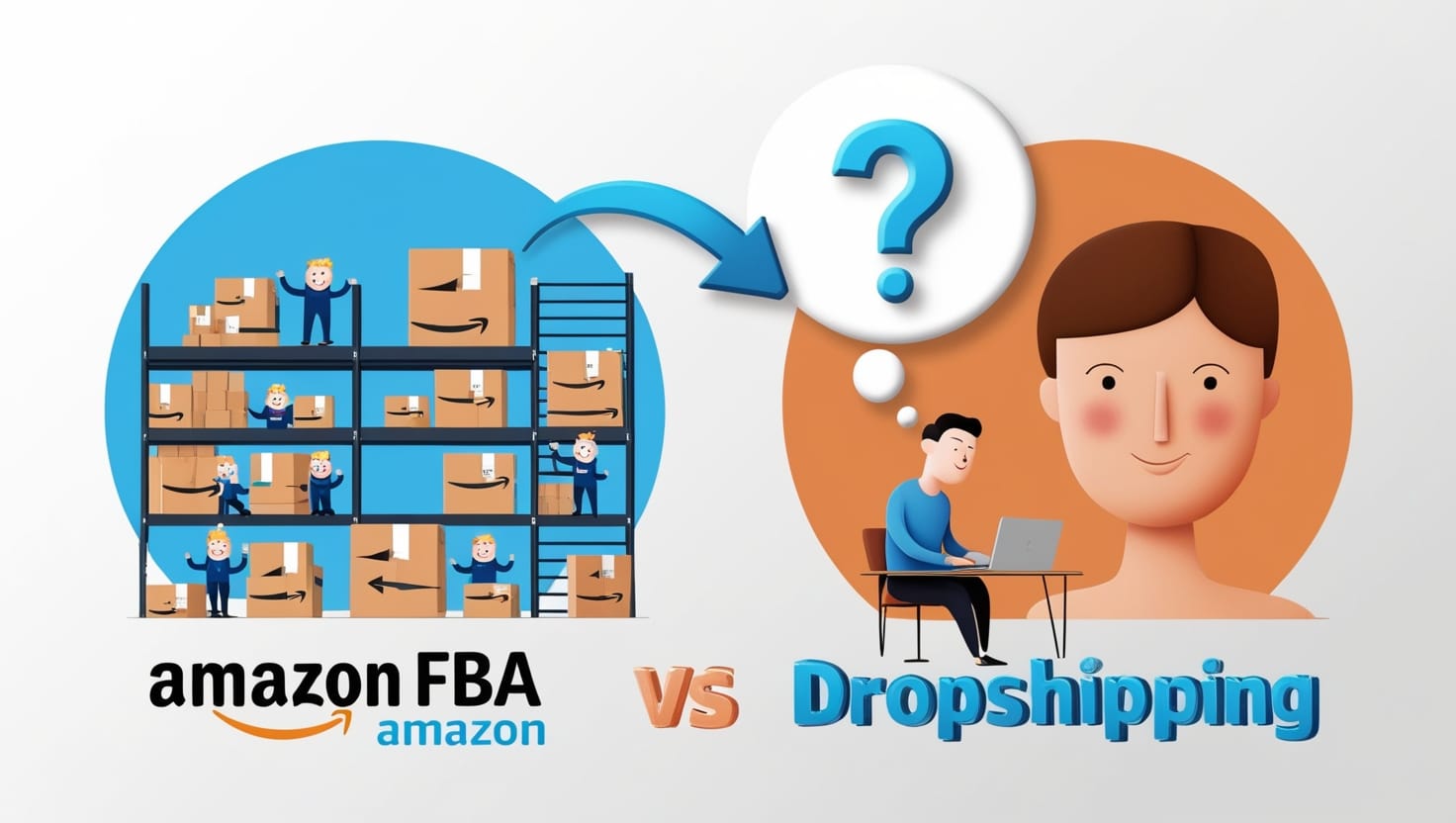introduction
In today’s world of e-commerce, Amazon FBA (Fulfilled by Amazon) and dropshipping have emerged as popular ways to launch a profitable online store. Each has its benefits and challenges, but choosing the right model for your business can be the key to your success. Here’s an in-depth look at how Amazon FBA and dropshipping work, along with the pros and cons to help you make an informed choice.
1. Understanding Amazon FBA
Amazon FBA allows sellers to store products in Amazon’s fulfillment centers, where Amazon handles storage, shipping, and customer service. As one of the biggest online marketplaces globally, Amazon makes it easier for sellers to reach a vast audience without managing their own logistics.
Key Features of Amazon FBA:
- Inventory Storage: Sellers send their products to Amazon warehouses, where Amazon handles storage and inventory.
- Order Fulfillment: Amazon packs, ships, and handles returns for each order.
- Customer Service: Amazon offers 24/7 customer service, saving sellers time on support.
- Prime Shipping: Products are eligible for Amazon Prime, boosting visibility and attracting Prime members.
Advantages of Amazon FBA:
- Access to a Large Customer Base: Amazon has millions of active users, giving your products high visibility.
- Fast Shipping with Amazon Prime: Customers often prefer Prime, which means faster shipping and more orders.
- Hassle-Free Logistics: Amazon handles warehousing, packaging, shipping, and returns, reducing time on logistics.
- Customer Trust: Amazon is a trusted marketplace, which can increase the credibility of your listings.
Disadvantages of Amazon FBA:
- Fees and Charges: Amazon FBA has various fees, including fulfillment fees and storage fees, which can add up, especially for large or slow-moving inventory.
- Storage Limits: Sellers face storage limits and potential fees for excess inventory.
- Product Compliance: Amazon has strict policies, and products must meet specific requirements.
- Competition with Amazon: Some products may end up competing with Amazon’s own listings or other third-party sellers, especially if they perform well.
2. Understanding Dropshipping
Dropshipping allows sellers to sell products without holding inventory. Instead, when a customer orders, the seller purchases the product from a third-party supplier who ships it directly to the customer. This model can be less costly to start, as it doesn’t require upfront inventory purchases.
Key Features of Dropshipping:
- No Inventory Storage: Sellers list products and only pay for them when they make a sale.
- Third-Party Fulfillment: The supplier handles shipping and logistics directly to the customer.
- E-commerce Platform Flexibility: Sellers can use platforms like Shopify, eBay, or even Amazon to list products.
- Variety of Products: Sellers can quickly expand or pivot their catalog without large investments.
Advantages of Dropshipping:
- Low Startup Costs: Sellers don’t need to invest heavily in inventory, lowering financial risk.
- Flexible Product Range: It’s easy to add or remove products based on trends without incurring storage costs.
- Scalable Business Model: Dropshipping can be scaled up quickly, especially with a reliable supplier.
- No Warehouse Needed: Sellers don’t need physical storage, freeing up costs associated with warehousing.
Disadvantages of Dropshipping:
- Lower Profit Margins: Sellers often face lower margins because of third-party supplier costs and high competition.
- Limited Control over Fulfillment: The seller depends on the supplier for timely shipping, packaging, and product quality.
- Shipping Times and Costs: Dropshipping often involves longer shipping times, especially with international suppliers.
- Branding Challenges: Since products are shipped directly from suppliers, branding and packaging customization are limited.
3. Comparing Amazon FBA and Dropshipping: Pros and Cons
| Feature | Amazon FBA | Dropshipping |
|---|---|---|
| Inventory | Requires upfront inventory purchase | No inventory needed; order on demand |
| Logistics | Amazon handles shipping, returns, and storage | Supplier manages logistics |
| Customer Service | Amazon offers 24/7 support | Seller handles customer service |
| Profit Margins | Generally higher, but affected by Amazon’s fees | Lower due to supplier and shipping costs |
| Startup Costs | Higher due to inventory and FBA fees | Lower, as there’s no inventory investment |
| Brand Control | Limited to product listing and packaging | Limited by supplier’s packaging options |
| Shipping Speed | Fast, especially with Amazon Prime | Longer, especially with overseas suppliers |
Both models offer unique benefits and challenges depending on your business goals, resources, and customer expectations.
4. Which Business Model is Right for You?
When choosing between Amazon FBA and dropshipping, consider factors such as your budget, risk tolerance, and desire for control over the business.
- Amazon FBA may be better if you:
- Are willing to invest in inventory and logistics.
- Want access to Amazon’s extensive customer base and Prime benefits.
- Prioritize fast shipping and a streamlined fulfillment process.
- Don’t mind paying Amazon’s fees in exchange for the services provided.
- Dropshipping might be ideal if you:
- Have limited startup funds and prefer a low-risk option.
- Want to offer a broad or flexible range of products without committing to inventory.
- Are comfortable with potentially longer shipping times.
- Want to focus on product marketing rather than logistics.
5. Getting Started with Amazon FBA or Dropshipping
Tips for Starting with Amazon FBA:
- Choose Your Products Carefully: Research products that sell well on Amazon with reasonable competition and profit margins.
- Calculate Fees and Profits: Use Amazon’s FBA calculator to understand fees and estimate your profit margins.
- Create High-Quality Listings: Invest in quality product images and SEO-optimized descriptions.
- Optimize Inventory: Avoid excess stock and stay aware of Amazon’s inventory fees to reduce costs.
Tips for Starting with Dropshipping:
- Research Reliable Suppliers: Look for reputable suppliers with a track record of quality and on-time shipping.
- Choose a Platform: Consider platforms like Shopify or WooCommerce, which integrate with dropshipping apps like Oberlo or Spocket.
- Focus on Marketing: Since margins are lower, effective marketing through social media, SEO, and ads can drive sales.
- Manage Customer Expectations: Be transparent about shipping times and offer quality support to handle potential delays.
6. Conclusion: The Best Model Depends on Your Goals
Both Amazon FBA and dropshipping can be highly profitable if done right. Amazon FBA provides a fast fulfillment option with built-in customer trust and a vast marketplace but requires upfront investment. Dropshipping, on the other hand, has low startup costs and flexibility but can face issues with lower margins and shipping delays.
Ultimately, the best choice depends on your resources, risk tolerance, and long-term business vision. If you’re interested in building a brand and have capital to invest, Amazon FBA could be the route for you. For a flexible, low-risk entry into e-commerce, dropshipping might be your best option.

